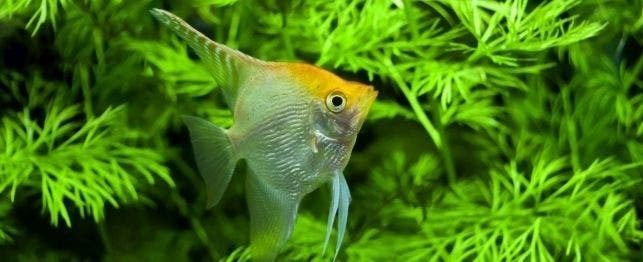
Choosing Freshwater Angelfish
Angelfish are probably the first fish a hobbyist will devote an entire tank to. Their peaceful languid appearance, strong markings and colorations in their fins make angelfish a lifelong hobby for many aquarists.
The angelfish, a member of the cichlid group, is native to the Amazon and South America. Because of the number of people who raise angels and their wide popularity, information regarding their habits and environmental requirements will vary. What works for one hobbyist will not work for all. Information offered here is a general guideline.
Appearance and Behavior
Most people do not have any trouble recognizing angelfish. The spectacular fins are eye catching and they have been bred to a variety of colors and patterns. Common varieties include:
- Marbles The strong vertical stripes are replaced by a mottled pattern of black on silver.
- Veil Tails The dorsal, tail and pectoral fins are enhanced in length and size for spectacular display.
- Half-blacks The back half of the fish is a solid glossy black, which breaks to a mottled tail fin.
Color varieties include lemon, pearl and blushing.
Angelfish grow rapidly and can reach sizes of up to 6 inches, exclusive of their fins. The young are peaceful but they become territorial as they mature and settle into breeding pairs. These fish breed easily and both parents actively defend the eggs and fry. The sexes are very hard to distinguish.
Feeding and Tank Requirements
Angelfish do best in a tall, deep, well-planted tank. Special lighting may be required to maintain live plants in deep tanks so ask your aquarium store if you’re lighting equipment is adequate. They do well on flake foods and are not difficult to feed. A special treat is mosquito larvae but take care to limit how much and how frequently this is offered, as they will overeat. Maintain tank temperature between 75 and 80 degrees Fahrenheit, with a pH balance of 7.0 to 7.5.
Special Concerns
Do not combine angelfish with neon tetras. The tetras are a natural prey species of the angels. They do get along well with many other fish and potential tank mates include glass catfish, festivum cichlids, kribensis, gourami and clown loach.
Angelfish are not always ideal parents. Sometimes the parents eat the fry, so monitor the babies or remove them to a safe location.